On Dipole Subwoofer Placement
In my earlier article on the subwoofer section of my four-way open baffle speaker, I chose a placement for the dipole subwoofer that is quite close to the listening position. I didn’t, however, perform additional measurements to determine more clearly how distance from the listener affects the response of the dipole subwoofer. While the nearby placement worked well in my listening room, can the results be generalized into a recommendation for others to try?
In this article, I describe a new series of measurements that explore how dipole subwoofer output is affected by the distance of the subwoofer from a) the listener and b) the wall behind it. In a real listening room, these two parameters can dramatically affect the amount of bass at the listening position.
Response versus distance to dipole subwoofer
As explained by John Kreskovsky in the technical article Dipole woofer on axis response in relation to listening distance, the 6 dB per octave drop in output of a dipole as frequency decreases will continue to DC only as the distance from the dipole approaches infinity. At realistic distances, the low-frequency response of the dipole flattens out at a frequency determined by the distance. In other words: there is more low bass the closer the dipole is to the listener.
To measure this, I positioned a test dipole panel on an outside deck adjoining the house. The test panel is a relatively small flat panel of approximately 36 by 54 cm, housing a 12″ woofer with the woofer center 22 cm from the floor. The dipole null was oriented towards the house to minimize reflections, although some were still expected – from the carport roof about a metre under the deck, and from objects such as a large tree and deck stairs and railings.
Figure 1 shows the measured responses at distances of 0.25, 0.5, 1, 2, and 4 meters. Examining the 0.25 m measurement, it can be seen that the dipole peak at around 400 Hz is already forming. Below that, the response drops slightly but levels out around 150 Hz. It is then fairly flat down to 30 Hz or so, where the natural roll-off of the woofer itself takes over. At each doubling of distance, the dipole roll-off continues to a lower frequency before levelling out. By the time we get to the 4 m measurement, though, reflections in the environment and some wind noise conspire against obtaining a clear plot.
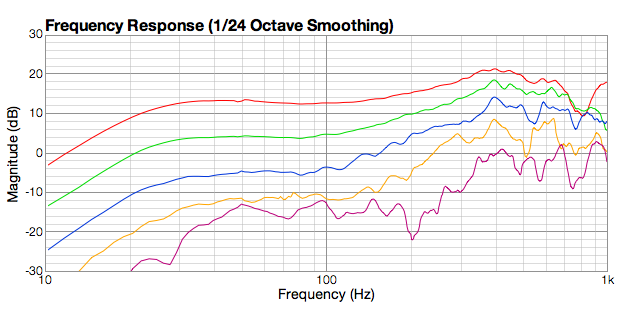
Figure 1. Response vs distance to dipole subwoofer at 0.25 (red), 0.5 (green), 1.0 (blue), 2.0 (orange), and 4.0 (mauve) meters
For a monopole in free space, SPL will drop by 6 dB each time distance is doubled. Figure 2 shows the same plots as Figure 1 (without the 4 m plot), but with each normalized to the 1 m plot by the expected multiple of 6 dB. It can be seen that above 200 Hz they are roughly equivalent (with the dipole peak not yet fully formed for the 0.25 m plot), but below around 150 Hz, the plots move away from each other. Thus, the measurements demonstrate that there is proportionally more low bass at closer distances, or conversely, less low bass at further distances.
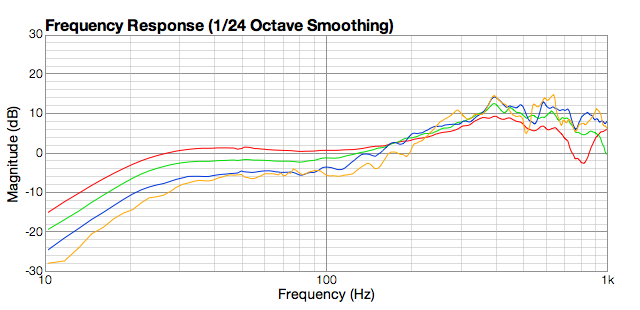
Figure 2. Normalized response vs distance to dipole subwoofer at 0.25 (red), 0.5 (green), 1.0 (blue), and 2.0 (orange) meters
Response versus distance to wall
In The Influence of Boundary Reinforcement on Monopole, Dipole and Cardioid Woofers, Kreskovsky shows how the frequency response in front of a monopole, dipole, or cardioid woofer is affected by reflection off a wall behind it. In the case of a dipole, reflection of the out-of-phase rear radiation reduces levels at low frequencies, in a manner that varies with distance from the wall.
To measure this effect, I placed the dipole panel in the positions shown in Figure 3, with the microphone level with the woofer and 1 m distant from it. The closest measurement to the wall is 0.3 m, not 0.25 m, because of a support projecting to the rear of the panel (it did not occur to me at the time to just turn the panel around so that the woofer cone faced the wall.) The other distances are 0.5, 1, and 2 m. Ideally, this measurement would have used an outdoor space with nothing but a large wall present, but I hoped that the approach taken to the indoor measurement would serve to show the effect anyway.
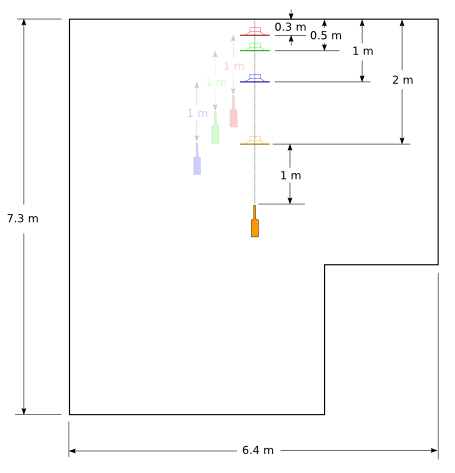
Figure 3. Placement of panel and microphone for measuring the effect of distance to rear wall
Figure 4 shows these measurements. The microphone is moved together with the panel so it is always a meter away. Some smoothing is applied to the plot because of room reflections, but it’s fairly clear that bass level does increase as the panel is moved away from the wall, although it seems that most of the benefit is obtained once the panel is a metre from the wall. Note however that this room is drywall on wood frame, and the effect may be more pronounced with brick or concrete construction.
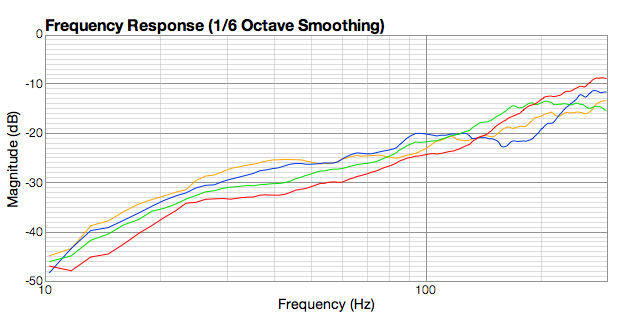
Figure 4. Effect of dipole distance from wall, at 0.3 (red), 0.5 (green), 1.0 (blue), and 2.0 (orange) meters, with mic at woofer height and 1 m distance
Effect of woofer height from floor
Up to now, the measurements have placed the microphone at woofer height, 22 cm off the floor. I now needed to raise the microphone up to a normal listening height. I wondered then whether the woofer should also be raised up to that height, as the distance from the woofer to the microphone is the tangent of the horizontal and vertical distances, and that is significant when the horizontal distance is short – see Figure 5. In addition, as the microphone moves off the dipole axis, SPL decreases even for constant woofer-microphone distance – by 3 dB at an angle of 45 degrees, for example.
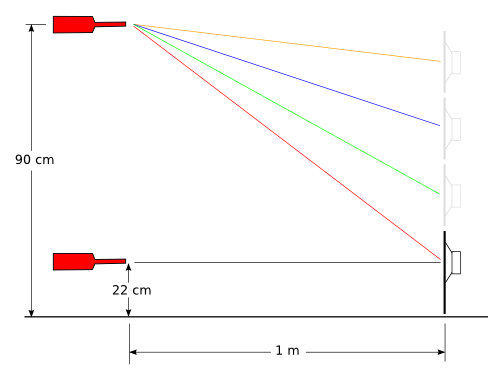
Figure 5. Measurement of the effect of woofer height
There is also another factor to consider: a woofer is best positioned close to the floor for bass response, as the woofer is then radiating only into half-space. So, moving the woofer off the floor will tend to decrease bass response, the opposite of what we are trying to achieve.
Figure 6 shows a set of measurements with the microphone at 90 cm from the floor and 1 m horizontal distance from the panel. The woofer panel was raised on blocks 20 cm at a time, placing the woofer center at 22, 42, 62, and 82 cm from the floor. The measurements show that the two effects mentioned above tend to cancel each other out at this distance – that is, for a horizontal listener-woofer distance of a metre, there is only a slight advantage in favour of raising the woofer. While I did not measure other distances, I would assume that at distances closer than a metre, the level at low frequencies will be higher with the woofer raised, and at distances further than a metre, it will be higher with the woofer on the floor.
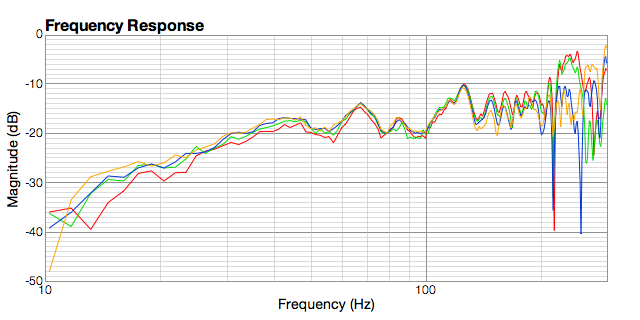
Figure 6. Effect of raising dipole subwoofer off floor in 20 cm increments, with microphone at 90 cm height and 1 m distance. Woofer center off floor: 22 (red), 42 (green), 62 (blue), and 82 (orange) cm
Effect of dipole subwoofer position
For a given listening position, the two distance-related effects described above should reinforce each other: moving the subwoofer closer to the listener also moves it away from the wall, and both of these factors will tend to increase bass response.
To confirm this with measurements, I positioned the microphone 90 cm off the floor and 3.5 m from the wall, and measured the response with the dipole panel moved in 0.5 m increments, from 0.5 m distance from the listener, to 0.5 m distance from the wall, as illustrated in Figure 7. The larger room dimensions are 6.4 x 7.3 m and the ceiling is 2.4 m high (21 x 24 x 8 feet). Recall that a dipole panel has nulls to the sides and to the ceiling, so we would expect that only the axial modes along the length of the room will be excited, at predicted frequencies of 23.5, 47, 70.5, and 94 Hz (the modes of this room are discussed in more detail in the earlier article).
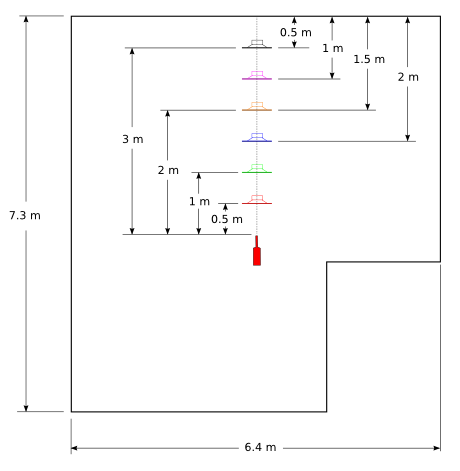
Figure 7. Placement of panel and microphone for subwoofer placement measurement
To avoid clutter, the measurements are shown in two graphs. Figure 8 shows the plots at 0.5, 1, and 1.5 m from the listener. There are two effects observable here. The general trend is that closer placement results in a higher level – this is most obvious in the bottom octave, and also in the 75-110 Hz region. We can also see that the second- and third-order axial modes along the length of the room, (2 0 0) and (3 0 0), are visible in the 1.5 m measurement.
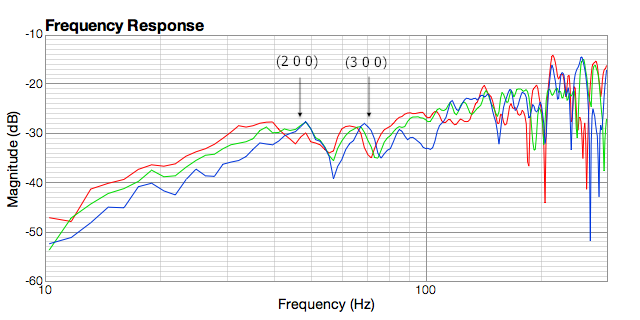
Figure 8. Dipole subwoofer at 0.5 (red), 1.0 (green), and 1.5 (blue) meters from listener
Figure 9 shows the plots at 2, 2.5, and 3 m from the listener. The subwoofer is now approaching the wall, with respective distances from the wall of 1.5, 1, and 0.5 m. While the effects of the length modes are visible, the level at all frequencies up to 90 Hz declines as the woofer approaches the wall.
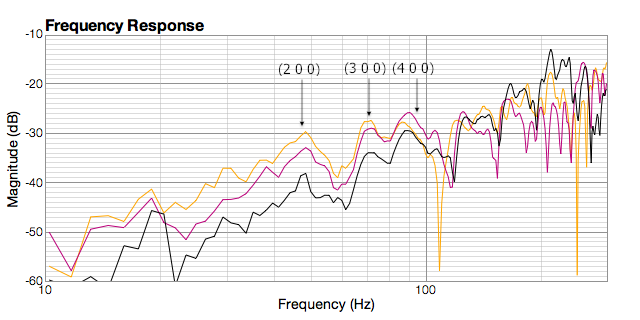
Figure 9. Dipole subwoofer at 2.0 (orange), 2.5 (mauve), and 3.0 (black) meters from listener
To highlight the variation in the response with position, Figure 10 shows just two plots, at 1 m from the listener and at 1 m from the wall (and therefore 2.5 m from the listener, a typical distance when subwoofers are placed on the plane of the main speakers). Because of modal effects, the 70-90 Hz region is a wash in terms of output level, but elsewhere there is a clear advantage for the closer positioning, by around 10 dB in the bottom octave and a few dB (on average) above 95 Hz.
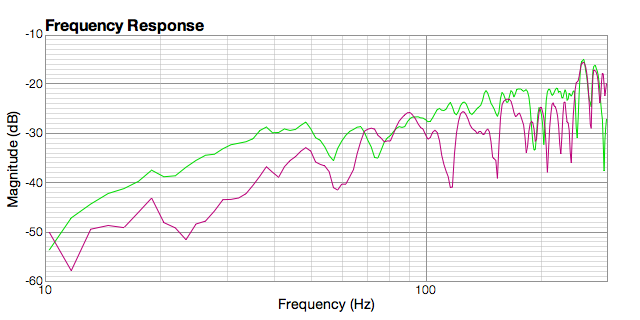
Figure 10. Dipole subwoofer at 1 meter from listener (green) and at 1 meter from wall (mauve)
Comparison with monopole subwoofer
While it may seem “intuitively obvious” that positioning a subwoofer closer to the listener will result in higher bass levels, this is not necessarily the case at low frequencies in a real room. To investigate this further, I placed a monopole (sealed) subwoofer in the same locations as above, and added an additional “on the wall” location with the woofer cone about 15 cm from the wall (as close as I can get it).
Figure 9 shows the effect as the subwoofer is moved away from the listener, at 0.5, 1, 1.5 and 2 m. The response does indeed get worse as the distance increases, both in terms of output level and smoothness.
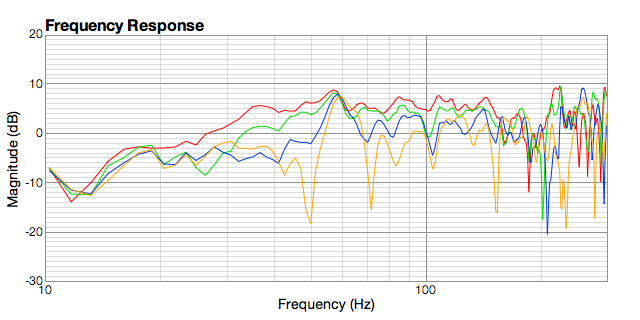
Figure 11. Monopole subwoofer at 0.5 (red), 1.0 (green), 1.5 (blue), and 2.0 (orange) meters from listener
As the subwoofer approaches the wall, however, the response improves again. Figure 10 shows the response of the “on the wall” position in mauve, and for comparison the response at 1 m from the listener in green. While the former is not as smooth as the latter, the output level is roughly the same up to about 100 Hz. This figure also shows the response with the subwoofer a meter from the wall in black – clearly, this is not a good placement in this room.
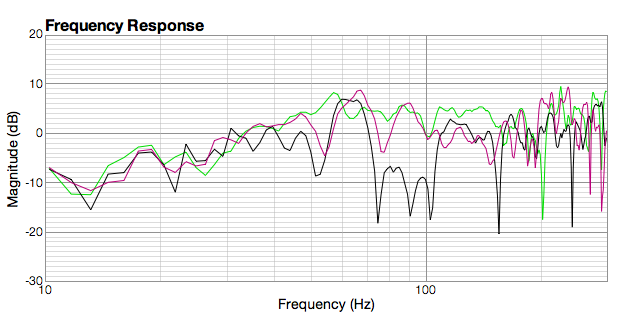
Figure 12. Monopole subwoofer at wall (mauve), 1m distance from listener (green), and 1 m off wall (black)
We must be careful to generalize from this measurement, as the monopole does not have the dipole’s nulls to the sides and ceiling. Nonetheless, the measurement does suggest that, if a monopole subwoofer can be located very close to the listener (half a metre), there may be benefit in doing so; otherwise, put it right up against the wall. This is a marked contrast to the progressive degradation of a dipole as it is moved away from the listener and closer to the wall.
Concluding remarks
For any subwoofer located close to the listener, it is critical that there are no extraneous noises, like aerodynamic noise from the woofer or buzzes and rattles from the panels or other nearby objects. It is also important that there be no vibration induced into the floor or nearby furniture – it may be necessary to use a “push-pull” (force-cancelling) woofer arrangement to achieve this. The low pass crossover frequency and slope may also play a factor in avoiding localization.
If the above issues can be addressed, the measurements show that there is significant benefit to locating a dipole subwoofer close to the listener – closer than is commonly considered. Obviously, this works best for a single listening seat, but if there are multiple seats then the use of multiple dipole subwoofers behind or beside the listening area could be considered.
Note that these results were obtained with a fairly small flat panel, and a subwoofer with a greater effective dipole separation should benefit even more from this effect. (See Figure 6 in the article Prototyping a Dipole Bass System for an example.) If you do try this type of placement, please post some information and a link to your measurements in a comment below.
Acknowledgements
This article was greatly improved by comments from Paul Spencer (redspade-audio.blogspot.com.au) and Rudolf Finke (www.dipolplus.de).
The measurements in this article were performed with FuzzMeasure Pro, donated by Chris Liscio to HifiZine for use in technical articles and tutorials. Thank you for your support!



